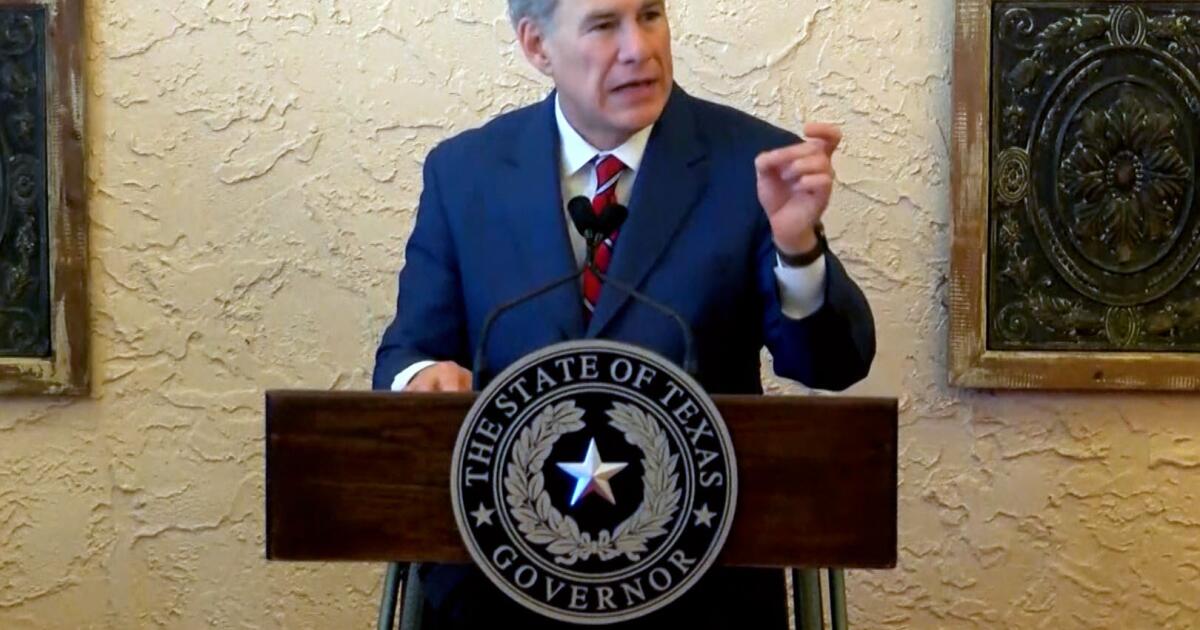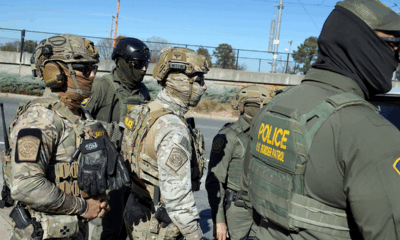Politics
Video: Trump Pardons Nearly All Involved in Jan. 6 Attack

On his first day back in office, President Trump pardoned all of the nearly 1,600 people charged in connection with the attack on the Capitol on Jan. 6, 2021. Maggie Haberman, White House correspondent for The New York Times, describes what’s behind those pardons.

Politics
War on badges: House GOP targets anti-police rhetoric amid ICE attacks

NEWYou can now listen to Fox News articles!
FIRST ON FOX: The House Homeland Security Committee will hold a hearing Dec. 3 examining anti-law enforcement rhetoric — and how it might be tied to an increase in violence against law enforcement officers and Immigration and Customs Enforcement (ICE) officers.
The hearing comes in response to several attacks against ICE officers and as the Department of Homeland Security reports that violent encounters against federal immigration officials have surged in recent months.
“It is unacceptable that the brave men and women of law enforcement, who risk their lives daily to secure the homeland and protect the public, are facing targeted violence from radicals and international gangs on U.S. soil,” House Homeland Security Committee Andrew Garbarino, R-N.Y., said in a Monday statement to Fox News Digital.
Dallas Police investigate the scene where a shooter opened fire on a U.S. Immigration and Customs Enforcement facility, Sept. 24, 2025 in Dallas. (Stewart F. House/Getty Images)
“With assaults against officers skyrocketing and heightened threats of political violence across America, Congress must support the mission of law enforcement and ensure our federal agencies have the tools, resources, and partnerships needed to keep these dedicated professionals safe on the job as they work to protect our communities,” Garbarino said.
FROM WORDS TO BLOODSHED: DEMOCRATS BLASTED FOR RHETORIC AFTER DEADLY ICE SHOOTING
Those who will appear before the committee Dec. 3 for the hearing, titled “When Badges Become Targets: How Anti-Law Enforcement Rhetoric Fuels Violence Against Officers,” include Michael Hughes, executive director of the Federal Law Enforcement Officers Association; Patrick Yoes, national president of the Fraternal Order of Police; and Jonathan Thompson, executive director and CEO of the National Sheriffs’ Association.
HOUSE REPUBLICANS WARN ANTI-ICE RHETORIC FROM DEMOCRATS IS DRIVING VIOLENT ATTACKS ON AGENTS
There have been a series of shootings at ICE facilities in 2025, and the Department of Homeland Security said in July that assaults against ICE officers and other federal immigration agents have increased nearly 700% in comparison to 2024. Although the agency reported 10 assault incidents between Jan. 1, 2024, and June 30, 2024, that number increased to 79 reported assaults in the same period of time in 2025.
Law enforcement agents look around the roof of a building near the scene of a shooting at a U.S. Immigration and Customs Enforcement office in Dallas, Texas, Sept. 24, 2025. (Julio Cortez)
Recent cases of violence against law enforcement include a shooting near ICE’s Prairieland Detention Facility in Alvarado, Texas, in July, where an Alvarado Police Department officer was shot in the neck. On Wednesday, five people pleaded guilty to terrorism-related charges stemming from the attack.
SANCTUARY POLITICIANS’ RHETORIC LED TO 1,150% SURGE IN VIOLENCE AGAINST ICE AGENTS: DHS
More recently, a shooter opened fire at an ICE facility in Dallas in September, and two detainees died. At the time, the FBI said it would investigate the matter as a “targeted attack” against ICE, and the Department of Homeland Security said it had identified shell casings with “anti-ICE” messages.
“Federal law enforcement agencies play a critical role in upholding the rule of law, protecting our national security, and supporting both state and local authorities,” Rep. August Pfluger, the chairman of the Homeland Security Committee’s counterterrorism and intelligence subcommittee, said in a Monday statement to Fox News Digital.
Rep. August Pfluger, R-Texas, participates in the House Republicans news conference in the Capitol to discuss defunding the Homeland Security Departments Disinformation Governance Board on Wednesday, May 11, 2022. (Bill Clark/CQ-Roll Call, Inc via Getty Images)
“The recent deadly shooting at a Dallas ICE facility wasn’t an isolated attack — it was part of a broader pattern of violence spurred on by anti-law enforcement rhetoric and heightened political extremism perpetrated by radicals on the Left,” said Pfluger, who is from Texas.
CLICK HERE TO DOWNLOAD THE FOX NEWS APP
Meanwhile, the White House previously has urged Democrats to tamp down their language toward ICE as they challenge the Trump administration’s mass deportation agenda.
For example, Rep. Pramila Jayapal, D-Wash., blamed ICE for acting “like a terrorist force” in June. She later stood by her comments in a CNN interview, after the White House pressed her for an apology.
Politics
In Texas case, it’s politics vs. race at the Supreme Court, with control of Congress at stake

WASHINGTON — The Texas redistricting case now before the Supreme Court turns on a question that often divides judges: Were the voting districts drawn based on politics, or race?
The answer, likely to come in a few days, could shift five congressional seats and tip political control of the House of Representatives after next year’s midterm elections.
Justice Samuel A. Alito, who oversees appeals from Texas, put a temporary hold on a judicial ruling that branded the newly drawn Texas voting map a “racial gerrymander.”
The state’s lawyers asked for a decision by Monday, noting that candidates have a Dec. 8 deadline to file for election.
They said the judges violated the so-called Purcell principle by making major changes in the election map “midway through the candidate filing period,” and that alone calls for blocking it.
Texas Republicans have reason to be confident the court’s conservative majority will side with them.
“We start with a presumption that the legislature acted in good faith,” Alito wrote for a 6-3 majority last year in a South Carolina case.
That state’s Republican lawmakers had moved tens of thousands of Black voters in or out of newly drawn congressional districts and said they did so not because of their race but because they were likely to vote as Democrats.
In 2019, the conservatives upheld partisan gerrymandering by a 5-4 vote, ruling that drawing election districts is a “political question” left to states and their lawmakers, not judges.
All the justices — conservative and liberal — say drawing districts based on the race of the voters violates the Constitution and its ban on racial discrimination. But the conservatives say it’s hard to separate race from politics.
They also looked poised to restrict the reach of the Voting Rights Act in a pending case from Louisiana.
For decades, the civil rights law has sometimes required states to draw one or more districts that would give Black or Latino voters a fair chance to “elect representatives of their choice.”
The Trump administration joined in support of Louisiana’s Republicans in October and claimed the voting rights law has been “deployed as a form of electoral race-based affirmative action” that should be ended.
If so, election law experts warned that Republican-led states across the South could erase the districts of more than a dozen Black Democrats who serve in Congress.
The Texas mid-decade redistricting case did not look to trigger a major legal clash because the partisan motives were so obvious.
In July, President Trump called for Texas Republicans to redraw the state map of 38 congressional districts in order to flip five seats to oust Democrats and replace them with Republicans.
At stake was control of the closely divided House after the 2026 midterm elections.
Gov. Greg Abbott agreed, and by the end of August, he signed into law a map with redrawn districts in and around Houston, Dallas, Fort Worth and San Antonio.
But last week federal judges, in a 2-1 decision, blocked the new map from taking effect, ruling that it appeared to be unconstitutional.
“The public perception of this case is that it’s about politics,” wrote U.S. District Judge Jeffrey V. Brown in the opening of a 160-page opinion. “To be sure, politics played a role” but “substantial evidence shows that Texas racially gerrymandered the 2025 map.”
He said the strongest evidence came from Harmeet Dhillon, the Trump administration’s top civil rights lawyer at the Justice Department. She had sent Abbott a letter on July 7 threatening legal action if the state did not dismantle four “coalition districts.”
This term, which was unfamiliar to many, referred to districts where no racial or ethnic group had a majority. In one Houston district that was targeted, 45% of the eligible voters were Black and 25% were Latino. In a nearby district, 38% of voters were Black and 30% were Latino.
She said the Trump administration views these as “unconstitutional racial gerrymanders,” citing a recent ruling by the conservative 5th Circuit Court.
The Texas governor then cited these “constitutional concerns raised by the U.S. Department of Justice” when he called for the special session of the Legislature to redraw the state map.
Voting rights advocates saw a violation.
“They said their aim was to get rid of the coalition districts. And to do so, they had to draw new districts along racial lines,” said Chad Dunn, a Texas attorney and legal director of UCLA’s Voting Rights Project.
Brown, a Trump appointee from Galveston, wrote that Dhillon was “clearly wrong” in believing these coalition districts were unconstitutional, and he said the state was wrong to rely on her advice as basis for redrawing its election map.
He was joined by a second district judge in putting the new map on hold and requiring the state to use the 2021 map that had been drawn by the same Texas Republicans.
The third judge on the panel was Jerry Smith, a Reagan appointee on the 5th Circuit Court, and he issued an angry 104-page dissent. Much of it was devoted to attacking Brown and liberals such as 95-year-old investor and philanthropist George Soros and California Gov. Gavin Newsom.
“In 37 years as a federal judge, I’ve served on hundreds of three-judge panels. This is the most blatant exercise of judicial activism that I have ever witnessed,” Smith wrote. “The main winners from Judge Brown’s opinion are George Soros and Gavin Newsom. The obvious losers are the People of Texas.”
The “obvious reason for the 2025 redistricting, of course, is partisan gain,” Smith wrote, adding that “Judge Brown commits grave error in concluding that the Texas Legislature is more bigoted than political.”
Most federal cases go before a district judge, and they may be appealed first to a U.S. appeals court and then the Supreme Court.
Election-related cases are different. A three-judge panel weighs the facts and issues a ruling, which then goes directly to the Supreme Court to be affirmed or reversed.
Late Friday, Texas attorneys filed an emergency appeal and asked the justices to put on hold the decision by Brown.
The first paragraph of their 40-page appeal noted that Texas is not alone in pursuing a political advantage by redrawing its election maps.
“California is working to add more Democratic seats to its congressional delegation to offset the new Texas districts, despite Democrats already controlling 43 out of 52 of California’s congressional seats,” they said.
They argued that the “last-minute disruption to state election procedures — and resulting candidate and voter confusion —demonstrates” the need to block the lower court ruling.
Election law experts question that claim. “This is a problem of Texas’ own making,” said Justin Levitt, a professor at Loyola Law School in Los Angeles.
The state opted for a fast-track, mid-decade redistricting at the behest of Trump.
On Monday, Dunn, the Texas voting rights attorney, responded to the state’s appeal and told the justices they should deny it.
“The election is over a year away. No one will be confused by using the map that has governed Texas’ congressional elections for the past four years,” he said.
“The governor of Texas called a special session to dismantle districts on account of their racial composition,” he said, and the judges heard clear and detailed evidence that lawmakers did just that.
In recent election disputes, however, the court’s conservatives have frequently invoked the Purcell principle to free states from new judicial rulings that came too close to the election.
Granting a stay would allow Texas to use its new GOP friendly map for the 2026 election.
The justices may then choose to hear arguments on the legal questions early next year.
Politics
Trump launches ‘Genesis Mission’ to supercharge US scientific AI innovation

NEWYou can now listen to Fox News articles!
President Donald Trump signed an executive order Monday aimed at bolstering U.S. artificial intelligence (AI) initiatives as it unveiled its new “Genesis Mission” to accelerate AI use for scientific purposes.
The “Genesis Mission” will direct the Department of Energy (DOE) and the Office of Science and Technology Policy (OSTP) and their national labs to work with private companies to share federal data sets, advanced supercomputing capabilities, and scientific facilities.
TRUMP, MCCORMICK TO UNVEIL $90B ENERGY AND INNOVATION INVESTMENT IN PENNSYLVANIA
“The private sector has launched artificial intelligence at huge scale, but with a little bit different focus – on language, on business, on processes, on consumer services,” Secretary of Energy Chris Wright told reporters Monday. “What we’re doing here is just pivoting those efforts to focus on scientific discovery, engineering advancements. And to do that, you need the data sets that are contained across our national labs.”
Vice President JD Vance, left, and Energy Secretary Chris Wright, right, in Greenland while honoring the 55th anniversary of Earth Day 2025. (Reuters)
Additionally, the executive order instructs the Department of Energy and national labs to create an integrated platform aimed at expediting scientific discovery, in an attempt to connect AI capability with scientists, engineers, technical staff, and the labs’ scientific instruments, according to a White House official.
AI LAWNMOWERS CUT GRASS — AND POTENTIALLY COSTS — IN NATIONAL MALL TEST RUN
Trump hinted an effort like this was in the works during the U.S.-Saudi Investment Forum Wednesday in Washington, where he said the U.S. would work “to build the largest, most powerful, most innovative AI ecosystem in the world.”
US President Donald Trump during the US-Saudi Investment Forum at the Kennedy Center in Washington, DC, US, on Wednesday, Nov. 19, 2025. (Stefani Reynolds/Bloomberg via Getty Images)
The effort comes after Trump issued an AI policy document called “Winning the Race: America’s AI Action Plan” in July. The document laid out a framework focused on accelerating AI innovation, ensuring the U.S. is the leader in international AI diplomacy and security, and using the private sector to help build up and operate AI infrastructure.
ARTIFICIAL INTELLIGENCE DRIVES DEMAND FOR ELECTRIC GRID UPDATE
Meanwhile, the Trump administration is also currently considering other executive orders pertaining to AI, and more executive orders could be on the horizon.
For example, Fox News Digital previously reported that the White House was gearing up an executive order instructing the Justice Department to sue states that adopt their own laws regulating AI.
The Trump administration is prepping an executive order that would instruct the Justice Department to sue states that adopt their own laws that would regulate AI. (Samuel Corum/Bloomberg via Getty Images, left, and MANDEL NGAN/AFP via Getty Images, right.)
Trump appeared to address the initiative at the U.S-Saudi Investment Forum as well, claiming that a series of AI regulations imposed at the state level would prove a “disaster.”
CLICK HERE TO DOWNLOAD THE FOX NEWS APP
“And we are going to work it so that you’ll have a one approval process to not have to go through 50 states,” Trump said.
Fox News’ Amanda Macias and Dennis Collins contributed to this report.
-
Business1 week ago
Fire survivors can use this new portal to rebuild faster and save money
-

 World7 days ago
World7 days agoFrance and Germany support simplification push for digital rules
-

 News1 week ago
News1 week agoCourt documents shed light on Indiana shooting that sparked stand-your-ground debate
-

 Science3 days ago
Science3 days agoWashington state resident dies of new H5N5 form of bird flu
-

 World1 week ago
World1 week agoSinclair Snaps Up 8% Stake in Scripps in Advance of Potential Merger
-

 World1 week ago
World1 week agoCalls for answers grow over Canada’s interrogation of Israel critic
-

 Politics1 week ago
Politics1 week agoDuckworth fires staffer who claimed to be attorney for detained illegal immigrant with criminal history
-

 World1 week ago
World1 week ago2% of Russian global oil supply affected following Ukrainian attack






















